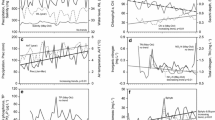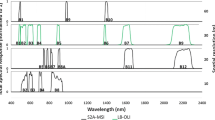Abstract
We used data collected from 1989 to 2009 from 151 shallow (mean depth < 3 m) temperate lakes in Denmark to explore the influence of lake trophic status, surface area and catchment size on the seasonal dynamics of the air–water flux of CO2. Monthly CO2 fluxes were derived from measurements of acid neutralizing capacity (ANC), pH, ionic strength, temperature, and wind speed. CO2 fluxes exhibited large seasonal variability, in particular in oligo-mesotrophic lakes. Most of the lakes emitted CO2 during winter (median rates ranging 300–1,900 mg C m−2 day−1), and less CO2 during summer or, in the case of some of the highly eutrophic lakes, retained CO2 during summer. We found that seasonal CO2 fluxes were strongly negatively correlated with pH (r = −0.65, P < 0.01), which in turn was correlated with chlorophyll a concentrations (r = 0.48, P < 0.01). Our analysis suggests that lake trophic status (a proxy for pelagic production) interacts with the lake ANC to drive the seasonal dynamics of CO2 fluxes, largely by changing pH and thereby the equilibrium of the free CO2 and bicarbonate relation. Long-term observations from four lakes, which have all undergone a period of oligotrophication during the past two decades, provide further evidence that CO2 efflux generally increases as trophic status decreases, as a consequence of decreased pH. Across these four lakes, the annual average CO2 emission has increased by 32% during the past two decades, thus, demonstrating the strong link between lake trophic status and CO2 flux.







Similar content being viewed by others
References
Bade DL, Cole JJ. 2006. Impact of chemically enhanced diffusion on dissolved inorganic carbon stable isotopes in a fertilized lake. J Geophys Res 111:10p.
Butler JN. 1991. Carbon dioxide equilibria and their applications. Boca Raton: CRC Press. p 272p.
Cole JJ, Caraco NF, Kling GW, Kratz TK. 1994. Carbon dioxide supersaturation in the surface waters of lakes. Science 265:1568–70.
Cole JJ, Caraco NF. 1998. Atmospheric exchange of carbon dioxide in a low-wind oligotrophic lake measured by the addition of SF6. Limnol Oceanogr 43:647–56.
Cole JJ, Prairie YT, Caraco NF, McDowell WH, Tranvik LJ, Striegl RG, Duarte CM, Kortelainen P, Downing JA, Middelburg JJ. 2007. Plumbing the global carbon cycle: integrating inland waters into the terrestrial carbon budget. Ecosystems 10:172–85.
Crusius J, Wanninkhof R. 2003. Gas transfer velocities measured at low wind speed over a lake. Limnol Oceanogr 48:1010–17.
del Giorgio PA, Peters RH. 1994. Patterns in planktonic P:R ratios in lakes: influence of lake trophy and dissolved organic carbon. Limnol Oceanogr 39:772–87.
del Giorgio PA, Cole JJ, Caraco NF, Peters RH. 1999. Linking planktonic biomass and metabolism to net gas fluxes in northern temperate lakes. Ecology 80:1422–31.
Fee EJ, Hecky RE, Kasian SEM, Cruikshank DR. 1996. Effects of lake size, water clarity, and climatic variability on mixing depths in Canadian Shield lakes. Limnol Oceanogr 41:912–20.
Hanson PC, Bade DL, Carpenter SR, Kratz TK. 2003. Lake metabolism: relationships with dissolved organic carbon and phosphorus. Limnol Oceanogr 48:1112–19.
Hanson PC, Carpenter SR, Cardille JA, Coe MT, Winslow LA. 2007. Small lakes dominate a random sample of regional lake characteristics. Freshw Biol 52:814–22.
Herczeg AL, Fairbanks RG. 1987. Anomalous carbon isotope fractionation between atmospheric CO2 and dissolved inorganic carbon induced by intense photosynthesis. Geochim Cosmochim Acta 51:895–9.
Jeppesen E, Søndergaard M, Jensen JP, Mortensen E, Hansen A-M, Jørgensen T. 1998. Cascading trophic interactions from fish to bacteria and nutrients after reduced sewage loading: an 18-year-study of a shallow hypertrophic lake. Ecosystems 1:250–67.
Jeppesen E, Jensen JP, Søndergaard M, Lauridsen TL. 2005. Response of fish and plankton to nutrient loading reduction in 8 shallow Danish lakes with special emphasis on seasonal dynamics. Freshw Biol 50:1616–27.
Kelly CA, Fee E, Ramlal PS, Rudd JWM, Hesslein RH, Anema C, Schindler EU. 2001. Natural variability of carbon dioxide and net epilimnetic production in the surface waters of boreal lakes of different sizes. Limnol Oceanogr 46:1054–64.
Kling GW, Kipphut GW, Miller MC. 1991. Arctic lakes and streams as gas conduits to the atmosphere: implications for tundra carbon budgets. Science 251:298–301.
Kling GW, Kipphut GW, Miller MC. 1992. The flux of CO2 and CH4 from lakes and rivers in arctic Alaska. Hydrobiologia 240:23–36.
Kuss J, Schneider B. 2004. Chemical enhancement of the CO2 gas exchange at a smooth seawater surface. Mar Chem 91:165–74.
Lazzarino JK, Bachmann RW, Hoyer MV, Canfield DE. 2009. Carbon dioxide supersaturation in Florida lakes. Hydrobiologia 627:169–80.
Liboriussen L, Jeppesen E. 2003. Temporal dynamics in epipelic, pelagic and epiphytic algal production in a clear and a turbid shallow lake. Freshw Biol 48:418–31.
Nõges T. 2009. Relationships between morphometry, geographic location and water quality parameters of European lakes. Hydrobiologia 633:33–43.
Ojala A, Bellido JL, Tulonen T, Kankaala P, Huotarib J. 2011. Carbon gas fluxes from a brown-water and a clear-water lake in the boreal zone during a summer with extreme rain events. Limnol Oceanogr 56:61–76.
Provoost P, van Heuven S, Soetaert K, Laane R, Middelburg JJ. 2010. Long-term record of pH in the Dutch coastal zone: a major role for eutrophication-induced changes. Biogeosci Discuss 7:4127–52.
Riera JL, Schindler JE, Kratz TK. 1999. Seasonal dynamics of carbon dioxide and methane in two clear-water lakes and two bog lakes in northern Wisconsin, USA. Can J Fish Aquat Sci 56:265–74.
Russell LL. 1976. Chemical aspects of groundwater recharge with wastewaters, Ph.D. Thesis, University of California, Berkeley, CA.
Sand-Jensen K, Staehr PA. 2007. Scaling of pelagic metabolism to size, trophy and forest cover in small Danish lakes. Ecosystems 10:128–42.
Sand-Jensen K, Staehr PA. 2009. Net heterotrophy in small Danish lakes: a widespread feature over gradients in trophic status and land cover. Ecosystems 12:336–48.
Schippers P, Vermaat JE, de Klein J, Mooij WM. 2004. The effect of atmospheric carbon dioxide elevation on plant growth in freshwater ecosystems. Ecosystems 7:63–74.
Snoeyink VL, Jenkins D. 1980. Water chemistry. New York: Wiley. p 476 p.
Staehr PA, Sand-Jensen K, Raun AL, Nilsson B, Kidmose J. 2010. Drivers of metabolism and net heterotrophy in contrasting lakes. Limnol Oceanogr 55:817–30.
Staehr PA, Baastrup-Spohr L, Sand-Jensen K, Stedmon C. 2011. Lake metabolism scales with lake morphometry and catchment conditions. Aquat Sci. doi:10.1007/s00027-011-0207-6.
Stumm W, Morgan JJ. 1996. Aquatic chemistry. New York: Wiley. p 1022 p.
Søndergaard M, Jeppesen E, Jensen JP, Amsinck SL. 2005a. Water framework directive: ecological classification of Danish lakes. J Appl Ecol 42:616–29.
Søndergaard M, Jensen JP, Jeppesen E. 2005b. Seasonal response of nutrients to reduced phosphorus loading in 12 Danish lakes. Freshw Biol 50:1605–15.
Søndergaard M, Johansson LS, Lauridsen TL, Jørgensen TB, Liboriussen L, Jeppesen E. 2010. Submerged macrophytes as indicators of the ecological quality of lakes. Freshw Biol 55:893–908.
Talling JF. 1976. The depletion of carbon dioxide from lake water by phytoplankton. J Ecol 64:79–121.
Tranvik LJ, Downing JA, Cotner JB, Loiselle SA, Striegl RG, Ballatore TJ, Dillon P, Finlay K, Fortino K, Knoll LB. 2009. Lakes and reservoirs as regulators of carbon cycling and climate. Limnol Oceanogr 54:2298–314.
Urabe J, Iwata T, Yagami Y, Kato E, Suzuki T, Hino S, Band S. 2011. Within-lake and watershed determinants of carbon dioxide in surface water: a comparative analysis of a variety of lakes in the Japanese Islands. Limnol Oceanogr 56:49–60.
Vestergaard O, Sand-Jensen K. 2000. Alkalinity and trophic state regulate aquatic plant distribution in Danish lakes. Aquat Bot 67:85–107.
Wetzel RG. 2001. Limnology: lake and river ecosystems. San Diego (CA): Academic Press.
Williamson CE, Dodds W, Kratz TK, Palmer MA. 2008. Lakes and streams as sentinels of environmental change in terrestrial and atmospheric processes. Front Ecol Environ 6:247–54.
Acknowledgments
We are grateful to CRES (Centre for Regional Change in the Earth System), REFRESH (a project on Adaptive Strategies to Mitigate the Impacts of Climate Change on European Freshwater Ecosystems, funded under the EU 7th Framework Programme), and CLEAR (a “Villum Kann Rasmussen Centre of Excellence Project on lake restoration”). PAS’s contribution was supported by the Danish Council for Independent Research, Natural Sciences Grant No. 10-085238. TD’s contribution was supported by Marie-Curie Intra European Fellowship No. 255180 (PRECISE).
Author information
Authors and Affiliations
Corresponding author
Additional information
Author Contributions
DT and EJ conceived and designed the study; DT analyzed the data; DT wrote the paper together with EJ, PAS, and TAD; RB, TLL, and MS contributed to data analysis and commented on the manuscript.
Rights and permissions
About this article
Cite this article
Trolle, D., Staehr, P.A., Davidson, T.A. et al. Seasonal Dynamics of CO2 Flux Across the Surface of Shallow Temperate Lakes. Ecosystems 15, 336–347 (2012). https://doi.org/10.1007/s10021-011-9513-z
Received:
Accepted:
Published:
Issue Date:
DOI: https://doi.org/10.1007/s10021-011-9513-z




